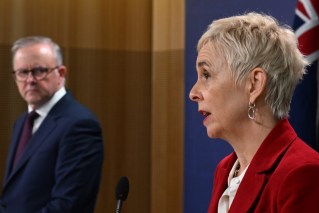Labour market, energy woes behind Aussie slowdown, says OECD
Australia’s growth outlook has been revised down slightly as the tight labour market and global energy crisis continue to fan inflation.

OECD boss and former Federal Minister Mattias Cormann. (Photo: AAP Image/Mick Tsikas)
The Organisation for Economic Co-operation and Development (OECD) expects real GDP growth of four per cent in 2022, down 0.1 percentage points from its interim September forecasts.
The UN body is then forecasting real GDP to grow by 1.9 per cent in 2023 – down marginally from the two per cent predicted earlier – before sinking to 1.6 per cent in 2024.
The OECD’s economic outlook report released on Wednesday pointed to the tight labour market as a key inflationary driver.
“Labour shortages are rife, with employment and participation rates near all-time highs, in part due to a fall in immigration since the beginning of the pandemic,” the report said.
The competitive labour market is feeding into relatively strong wage growth, with the wage price index lifting 3.1 per cent annually in the third quarter.
The war in Ukraine is also driving up energy prices and subsequently inflation, which hit 7.3 per cent year on year in the September quarter.
Inflationary pressures have prompted the Reserve Bank to lift interest rates rapidly, with the OECD tipping more hikes to get inflation back within its two to three per cent target range.
But as growth cools, so will tightness in the labour market.
“Inflationary pressures will diminish as the labour market cools and supply chain bottlenecks ease,” the report said.
The OECD expects inflation to simmer back down to 2.5 per cent by 2024.
But a key risk to Australia’s growth profile is house prices, with a larger-than-expected decline likely to sap growth further.
Globally, the OECD expects world growth to decline to 2.2 per cent as it faces the biggest energy crisis since the 1970s.
In 2024, it expects growth to recover modestly to 2.7 per cent.
“Asia will be the main engine of growth in 2023 and 2024, whereas Europe, North America and South America will see very low growth,” the report said.
Treasurer Jim Chalmers said Australia’s economy wasn’t immune from the economic hazards facing economies around the world.
“Slowing growth, high and persistent inflation, and falling real wages are all wreaking havoc in major economies, leading to a blunt and brutal application of monetary policy by the world’s central banks,” he said.
At the same time, Australian workers are on average working six weeks of unpaid overtime a year, according to Australia Institute research.
This amounts to more than $92 billion in “lost” pay in total, equivalent to 2.5 billion hours, or around $8000 a year per worker.
“This is time theft,” Australia Institute research economist Eliza Littleton said.
“The prevalence of overtime suggests that ‘availability creep’ has eroded the boundaries between work and life.”
Examples of unpaid overtime include checking emails on the weekend, taking multiple-time-zone calls out of hours and teleconferencing from the dining table, along with unspoken employer expectations that workers attend to work issues on their own time.
The report also showed 84 per cent of workers surveyed wanted the “right to disconnect” from work.












